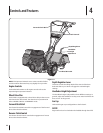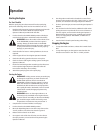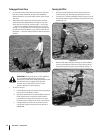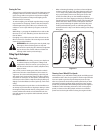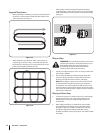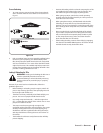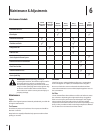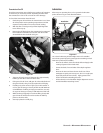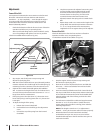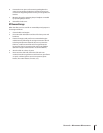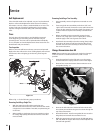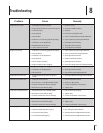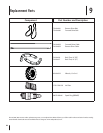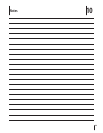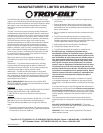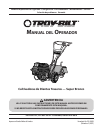
Adjustments
Forward Drive Belt
It is important to maintain the correct tension on the forward
drive belt. A loose belt will cause the tines and wheels to
slow down — or stop completely — even though the engine
is running at full speed. A belt that is too tight can result in
unintentional tine movement when the clutch bail is in the
Neutral (released) position.
Check the belt tension after the first two hours of break-in
operation and after every 10 operating hours.
At the end of each tilling season, check the belt for cracks,
cuts or frayed edges and replace it as soon as possible.
Check Forward Belt Tension (refer to Fig. 6-3):
Stop engine, wait for all parts to stop moving and
disconnect spark plug wire.
With the Forward Clutch Bail in an open (released) position,
measure and note the overall length of the cable spring by
measuring from the outermost coil to the outermost coil.
Squeeze the Forward Clutch Bail against the handlebar
and re-measure the length of the coils. The belt tension is
correct if this second measurement is between ⁄” -to- ⁄”
longer than the first measurement.
If the spring is too short (less than ⁄”), the tension is too
loose. If the spring is too long (more than ⁄”), the tension
is too tight.
To adjust the length of the spring:
Release the Forward Clutch Bail.
Unthread the hex nut halfway up the adjustment
screw.
Unhook the top of the spring from the Forward
Clutch Bail.
•
•
1.
2.
3.
4.
5.
a.
b.
c.
1
2
3
4
5
6
Cable Spring
Adjuster Spring
Hex Nut
Forward
Drive Cable
Forward
Clutch Bail
Figure 6-3
Use pliers to prevent the adjuster from turning and
turn the slotted screw located inside the spring
clockwise (viewed from operator’s position) to
increase tension on the spring. Turn the screw
counterclockwise to decrease tension. Once
adjusted, reattach the spring to the Forward Clutch
Bail.
Repeat Steps 2 and 3 to re-measure the length of the
spring. When the second measurement is between
⁄” -to- ⁄” longer than the first measurement,
retighten the hex nut against the top of the adjuster.
Reverse Drive Belt
Check the belt tension after the first two hours of break-in
operation and after every 10 operating hours.
To Check Reverse Belt Tension (Refer to Fig. 6-4):
Stop the engine, wait for all parts to stop moving and
disconnect the spark plug wire.
Remove the screw in the plastic belt cover and slide the
belt cover — which is attached to forward clutch cable
— out of the way.
Have an assistant pull the Reverse Clutch Control knob all
the way out and hold it in that position. Measure the length
of the cable wire between the end of the threaded cable
adjuster and the end of the Z-fitting to which the cable
wire is attached.
The belt tension is ideal if the cable wire length measures
between ⁄” to ⁄”. If it is less than ⁄” (and if there is no
reverse action when the tiller is running), then make the
following adjustments
NOTE: If the length is more than ⁄”, no adjustment is
needed — as long as the reverse action functions properly.
Release the Reverse Clutch Control knob and then
unthread the inner jam nut one to two turns. Pull the
threaded cable adjuster to the left until the inner jam nut
touches the bracket.
d.
e.
1.
2.
3.
4.
5.
Cable Adjuster
Inner
Jam Nut
Outer
Jam Nut
Z-Fitting
Figure 6-4
18 sectiOn 6— Maintenance & adjustMents



